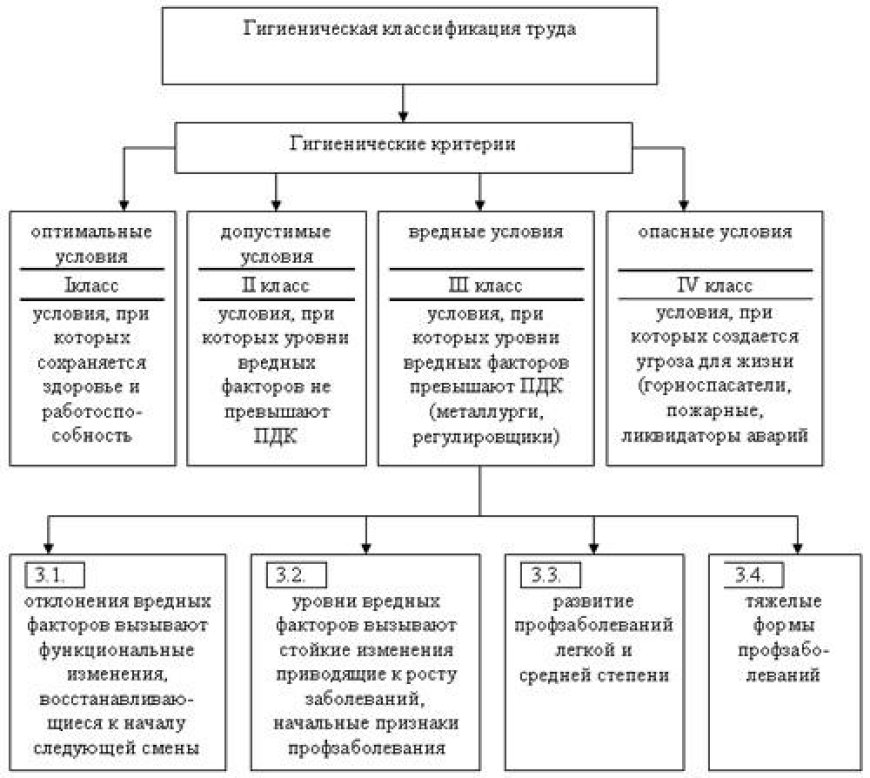Separation of working conditions
Depending on how the parameters of the production environment, climatic conditions, physical, psychological and intellectual loads deviate from the standards, working conditions are divided into four classes

What classes are divided into working conditions
Depending on how the parameters of the working environment, climatic conditions, physical, psychological and intellectual stress deviate from the standards, working conditions are divided into four classes: optimal, permissible, harmful, dangerous. Safe working conditions are classified into optimal (class 1) and acceptable (class 2). Harmful working conditions (class 3) are additionally subdivided into four subgroups according to the nature and degree of negative impact on human health, the likelihood of developing occupational diseases and chronic pathologies.

Optimum working conditions
The working environment, the form and degree of work loads that meet the standards and even below the established parameters, belong to the safest first class of working conditions. This means that in the process of work the employee is not affected by any harmful factors, physical, psychological and mental stress is optimal, conditions for rest and food are created, and the necessary sanitary and hygienic equipment is equipped.
Under such conditions, the employee is able to maintain a high level of working capacity for a long time. Such conditions, as a rule, are assigned to workplaces in convenient, comfortable offices, where recreation areas are equipped, breaks are provided, showers, and sports corners for employees are equipped. The main indicator is the low degree of fatigue of employees at the end of the working day.
Permissible working conditions
Class 2 belongs to safe working conditions, it is assigned to workplaces with a small number of harmful factors within the normal range. Under acceptable conditions, the degree of impact on the human body is such that it does not have serious consequences on the internal organs and functional systems of a person. An indicator of the second class of working conditions is a good rest and restoration of the employee's working capacity by the beginning of a new working day or shift.
Under safe working conditions (class 1 and 2), the employer:
- is not obliged to pay additional insurance premiums,
- does not have to pay extra to the employee for harmfulness,
- has the right to hire people without age and medical restrictions.
Important! If the requirements of labor protection are observed, the assignment of optimal and permissible working conditions based on the results of the SOUT relieves the employer of a special assessment for 10 years.
Harmful working conditions
The main characteristic of harmful working conditions is the excess of certain hygienic standards. Depending on the degree of exposure and the type of hazardous factors, work in hazardous working conditions provokes the development of disorders in the work of internal organs, there is a high risk of occupational diseases, loss of certain body functions.
Harmful working conditions are divided into subclasses according to the level and nature of negative factors:
- The class of working conditions 3.1 is characterized by increased loads during the labor process, which leads to the fact that the body does not have time to recover during the normal mode of work. This means that there is a risk of harm to health due to stress or various types of influences (not optimal temperature or sound conditions, the presence of impurities in the air). To reduce exposure and restore performance, workers need longer rest time and more time away from the work environment.
- The class of working conditions 3.2 is characterized by a stronger impact of harmful factors that cause persistent negative changes in the body of workers. According to experts, working conditions of class 3.2 can provoke chronic pathologies, but disability is not ascertained.
- Class 3.3 of harmful working conditions implies the presence of permanent harmful factors that can cause occupational diseases of moderate severity. According to experts, pronounced changes when working in class 3.2 conditions appear after 10 years of work, so employees need to undergo regular medical examinations. The employer is required to provide medical care, sanatorium and preventive treatment in order to reduce the risk of disability in full or in large part.
- Working conditions class 3.4 is characterized by an increased risk of developing occupational diseases, which can lead to partial or loss of ability to work during work. In such conditions, the risk of serious occupational diseases is very high, there is a risk of disability.
Hazardous working conditions
The highest degree of concentration of harmful factors belongs to the fourth class of working conditions. Depending on the type and nature of professional activity under hazardous working conditions, there is even a threat to life. Such conditions occur in direct contact with hazardous chemical and biological substances, in the presence of harmful radiation at the workplace. Unlike other categories, under hazardous working conditions, the risk to the health of workers occurs within one working day or shift. When assigning the fourth class of working conditions, the employer is obliged to make changes to the work process, upgrade equipment, and eliminate the high degree of exposure to harmful factors in the workplace.
What's Your Reaction?



























































